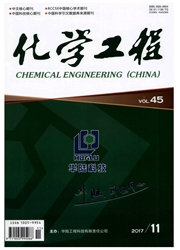

 中文摘要:
中文摘要:
国内气化炉在长周期运行中曾数次出现大块熔渣堵塞渣池出口的现象,严重制约了工业化装置的经济、安全、稳定运行。为了探讨大渣块形成的原因,文中搭建了气化炉及下部辐射废锅冷模装置,以糖浆作为介质模拟熔渣,对熔渣离开气化炉渣口后,在辐射废锅上部空间的流动特征进行了实验研究,考察了模拟介质黏度和渣口气速对熔渣流动特征的影响。研究发现:熔渣离开渣口落入废锅并非自由沉降过程,而是在人口处气流射流作用下发生破裂,由液膜形成液丝。当渣口气速较高时,部分熔渣在回流区气流卷吸作用下开始沉积到废锅壁面。熔渣在废锅壁面上的沉积率随着渣口气速的增大而增大,随着模拟介质黏度的增大而减小。而熔渣沉积区域离渣口的距离随着渣口气速的增大而减小,随着模拟介质黏度的增大而增大。
 英文摘要:
英文摘要:
In China, there are often big slag blockage at the slag tap hole region of entrained-flow gasifier during long time operation, which is an important threat to the economic, safe and stable operation of industrialization device. In order to explore the reason of slag blockage at the slag tap hole region of gasifier, a cold-model of gasifier and radiant syngas cooler was set up to observe the flow characteristics of slag in the upper space of radiant syngas cooler (RSC) with syrup as the medium. The effects of medium viscosity and air velocity on the characteristics of slag flow were investigated. The results indicate that the slag is broken up to slender liquid filaments by the inlet jet flow rather than flows into a water quenching system vertically under the force of gravity. When the air velocity is relatively high, a part of the filaments begin to deposit on the wall of RSC by the recirculating gas flow. The increase of air velocity enhances the deposition rate, while the increase of medium viscosity decreases the deposition rate. The distance between the deposition area of slag and slag tap hole decreases with the increasing of air velocity, and increases with the increasing of medium viscosity.
 同期刊论文项目
同期刊论文项目
 同项目期刊论文
同项目期刊论文
 期刊信息
期刊信息
